
Insta360 One R Review
Since getting my first 360 camera, I've loved the freedom of being in the moment with the ability to capture and frame my stories after the fact. This camera does that better than all previous cameras but also adds the ability to shoot like a traditional action camera through a unique set of mods optimized to "adapt" to the action.
What Is It?
The Insta360 ONE R is the first modular and adaptable action camera on the market. It does this by cleverly separating the brains, the lenses, and the battery into different swappable components.
The brains of it all is the Core Module. This contains the processor, the physical controls, and the 1-5/8" touchscreen, microphones, speaker, memory card slot, and USB-C port for charging and connectivity. It also has bi-directional connectors so that it can be mounted with the traditional lenses in both a front and back orientation so the screen can either be on the front or the back.
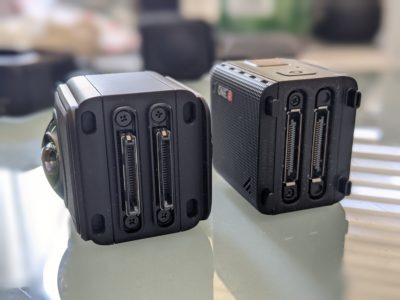
Modular pieces interconnect and seal out water.
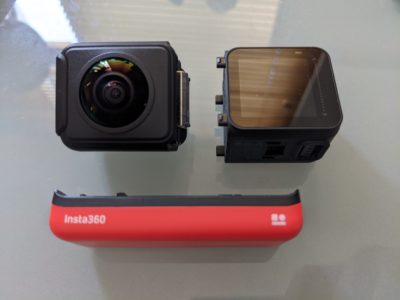
Modular design.
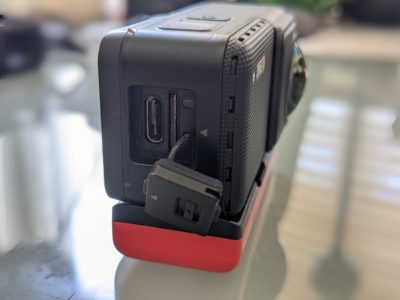
USB-C and memory card slot are protected with a weather sealed door.
The choice of lenses
are the Dual-Lens 360, the 4K Wide Angle, and the special Leica co-engineered
1-Inch Edition. The Dual-Lens 360 is the standard 5.7K 360 camera module. The
4K Wide Angle is their traditional action camera module capable of the typical
resolutions of 4K at up to 60 frames per second, 2.7K at up to 100 frames per
second, and 1080 (FullHD) at up to 200 frames per second. The 1-Inch Edition,
as its name implies, uses a 1" sensor to deliver up to 5.3K resolution and
stunning low light performance. It can drive 5.3K at up to 30 frames per
second, 4K or 2.7K a up to 60 frames per second, and 1080 (FullHD) at up to 120
frames per second. The lowlight is achieved due to 1-inch sensor being more
than 4 times the size of the 1/2.3-inch sensor found in the 4K Wide Angle
module. As a result, this makes the 1-Inch Edition a little bit larger
physically so that it can capture vastly more light.
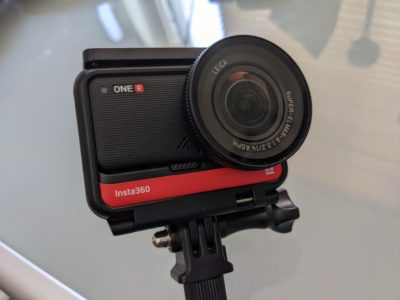
Standard configuration with 1-inch edition.
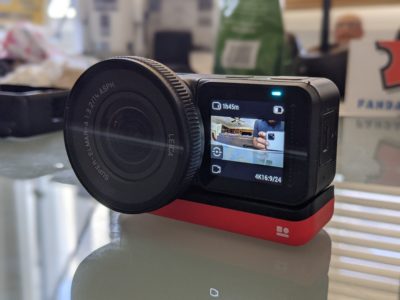
The screen can be flipped around for selfie mode.
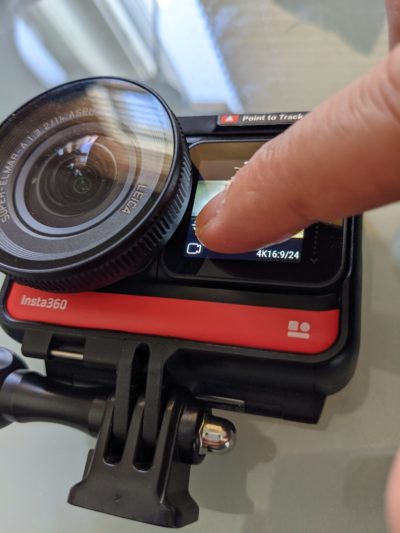
The 1-inch protective lens can partially block the touchscreen in selfie configuration.
The standard battery pack packs 1190 mAh and connects to both the lens and core locking everything together. The battery charges in 65 minutes and can last up to 70 minutes depending on conditions. There's also an optional double capacity battery available that packs 2380 mAh.
Combined together and inserted into its mounting bracket, the camera is rated IPX8 waterproof up to 5m (16.4ft) out of the box. With optional casing, it is possible to take the different configurations to even deeper. The mounting bracket itself can be used with either standard GoPro style mount or standard 1/4-20 mount. The mounting bracket also has mount points for optional lens guards for added protection or 3rd party ND filters for more control of light and shooting modes.
All the specifications can be found here:
I originally got the Twin Edition that comes with both the Dual Lens 360 and the 4K Wide Angle. I have since also added the 5.3K 1-Inch sensor. Admittedly, I no longer use actively use the 4K Wide Angle because the 5.3K 1-Inch sensor is so much better. This review will focus on the modules that I'm actively using.
Why Did I Get It?
After experiencing the freedom of running with a 360 camera for the last two years with the Rylo 360 Camera and an Insta360 One X, I wanted this new model to address some shortcomings I was experiencing: image quality, battery life, and water resistance. Additionally, I wanted to replace an aging traditional 4K action camera that also had similar shortcomings. The One R was the perfect device to replace both devices.
In the area of image quality, especially in low light, the One R Dual Lens 360 and 5.3K are a step above of what I had previously. Low light video is still a challenge for 360 cameras and the One R is not immune but it's still "better" than the previous generation especially when mounted statically vs. while moving. When set on a tripod, both the 360 and 5.3K lenses provide pretty good low light video and phenomenal low light photos.
For my previous cameras, I found that battery life was always an issue especially for adventures lasting more than 2 hours. I'd either have to carry additional batteries or have battery anxiety. They also seemed more susceptible to cold weather and would drain faster unless you had special batteries. The battery in the ONE R has made that anxiety go away and I can confidently take a single battery out for 4 hours of my typical shooting style.
The out-of-the-box waterproofing is probably one of the strongest points for this camera. I'm actually astounded they were able to do it with a modular design. Previously, I'd have to be extremely wary of using older 360 cameras in the rain or near water unless they were in a specialized case. I still use cases for ocean usage but it's nice having that peace of mind that you have some protection if the case fails.
Lastly, having an actual screen on the device has been helpful to changing settings on the camera, framing shots, and getting quick previews has been a helpful feature.
So, all in all, the upgrades to endurance, protection from the elements, usability, and image quality made this a worthwhile upgrade.
How Has It Worked Out
As a tool to help me document my runs and other adventures, the Insta360 ONE R has not disappointed. The continued ability to focus on what I'm doing and then tell my story later but in much better quality has been great.
My typical use case is to use the Dual-Lens 360 and pair it with the standard Insta360 Invisible Selfie Stick that extends nearly 1.2m (~4 ft) or sometimes with a 3rd party stick that can extend to 3m (~10ft) and take it on runs and hikes. In some cases, I carry it in the quiver of my trail running vest or I'll simple hand carry it for an entire run. Over the course of a run I will record 15-60 second clips depending on anything interesting I'm seeing or if I want a particular shot. The fun part is checking out the footage later to see what I got. Insta360 provides and mobile and desktop application that uses artificial intelligence to look for interesting things in your footage and edit a video for you but I prefer to manually go through my footage and edit it myself.
One cool thing is that you can review and edit the footage on your phone without needing to transfer all the files over first and sometimes I'll do quick edits entirely on my phone for sharing on social media. Other times, I'll transfer the files to my desktop computer and edit using their desktop app and then export to something I'm more familiar with like Adobe Premiere. You can record video in LOG mode so you can color correct later or use their standard color profiles which provide a nice vivid look out of the box.
Here are some
examples of things I've recorded using the Dual-Lens 360:
Here's an example running in the rain using the optional lens guards. The one nice thing about the guards is that they'll keep rain directly off the lenses which gives a nicer looking effect with less direct blurring of drops on the lens.
Admittedly, I use the 4K Wide Angle and 1-Inch Edition less often and when I do it's for more traditional usage like pre-planned shooting, timelapses, and for specific slow motion shots since both modules support higher quality images and frame rates. Here's one example:
Overall, I've been pretty happy with the camera in terms of usage and quality of footage. Admittedly, I'm mostly using it primarily as a 360 camera and then occasionally switching it out to the 4K Wide Angle or, more often, the 1-Inch Edition when I'm trying to shoot something specific. While it's relatively quick to swap lenses out, it does involve taking apart all the modules which is something I'm less inclined to do when I'm out in the field unless I'm specifically out filming stuff and not adventuring. Of course, it is nice having that flexibility.
The Good
- The Dual-Lens 360 footage is a step up from the previous generation.
- The 1-Inch Editions 5.3K resolution is fantastic for both photos and video.
- You can use the Dual-Lens 360 and 4K cameras as a webcam.
- Insta360 continues to add new features and capabilities to the device more than a year after it launched through firmware and app updates.
The Bad
- Operation can seem a little sluggish
- The touchscreen is almost unusable when the 1-Inch Edition is installed
- The 1-Inch Edition minimum focal distance is farther than I'd like. It's easy to be out of focus in selfie mode
- The door of the core module can be difficult to open when inside the mount
- The voice control is flaky.
- Stitching is not as good as slimmer offerings.
Is It Worth It?
If you're looking for a camera that can do it all and do it all very well then the Insta360 ONE R should be on your short list.